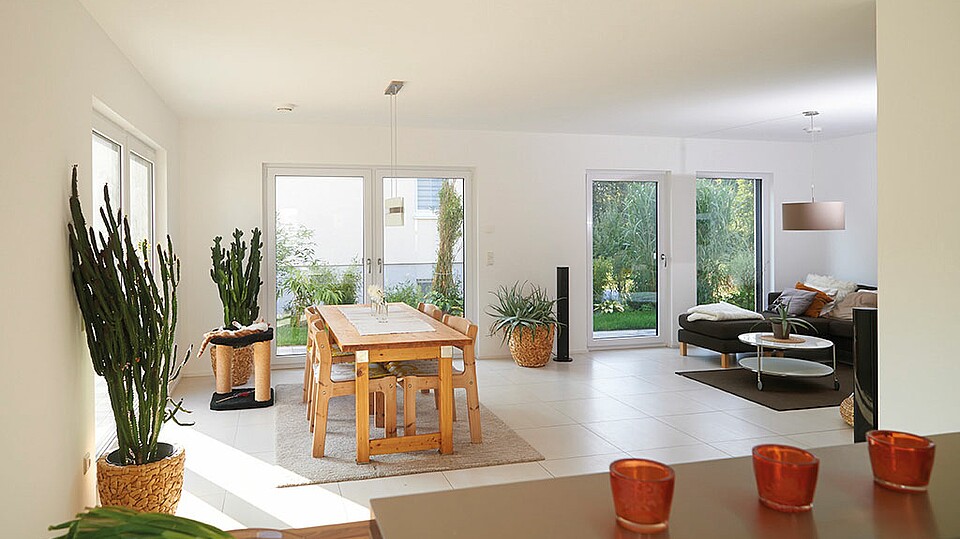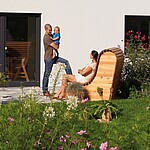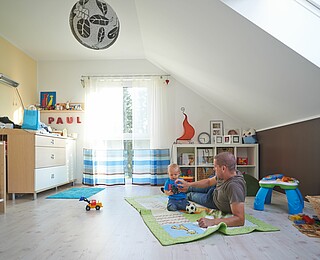A visit to the Hammer family’s Hanse Haus prefabricated house
Children learn at school that the world’s energy resources and raw materials are not infinite. Conserving these resources and looking for alternatives is referred to as sustainability. It goes without saying that this is an important matter particularly in homebuilding.
But doesn’t this limit one’s choices for house planning, fixtures and living comfort? Do significant compromises have to be made when conceptualising one’s home, and will this make building the house much more expensive?
The building project of the Hammer family from Nieder-Saulheim demonstrates just how relaxed Hanse Haus clients can be on the subject of sustainable building.
“Until now, sustainability has always meant for us – above all – a reduction in energy consumption and the low heating costs this entails. However, we learned just how many other aspects sustainability has over the course of our construction project – a Variant prefabricated house with pitched roof,” says homeowner Mike Hammer.
| Characteristics | |
|---|---|
| House series | Variant |
| House name | Variant |
| Use | Single-family house |
| Roof inclination | 35° |
| Jamb wall | 120 cm |
| Living space | 190,00 m² |
| Number of floors | 1 |
| Year of construction | 2013 |
| Level of completion | Turnkey houses |

Lots of praise from the Ministry of the Environment and the University of Munich
built
The family even has proof on paper that their new home is particularly sustainable.
This happened in the following way:
Together with the Federal Ministry for the Environment, Nature Conservation, Building and Nuclear Safety, the Munich University of Applied Sciences compiled a catalogue with a total of 18 criteria that can be used to assess the sustainability of a residential building. For a truly comprehensive evaluation, the criteria should cover the entire lifecycle of a home – from planning and inhabitation to the end of its useful life.
Subsequently, houses were sought out for a pilot study against which the evaluation criteria could be tested and further developed in practice. While many other project participants had show houses evaluated which were designed and built specifically to fulfil sustainability criteria, Hanse Haus presented the Hammer family’s home for realistic results that could be applied to other houses.
With an overall mark of 1.4, their construction project achieved an excellent rating and was thus one of the very best houses certified by the study.

“The idea of having our house certified immediately appealed to us.
Although we were sure that our house would perform well in terms of energy consumption and building materials, we were positively surprised by the overall result of the certification.”


Top marks for environmental compatibility and healthy living
future-orientated
“Our house received particularly good ratings in the categories of healthy living, sustainability of the building, environmental compatibility and construction quality. These are all requirements that we did not actively concern ourselves with as homebuilders but which Hanse Haus already fulfilled as part of its standard,” says the client, and adds: “We can also understand why Hanse Haus’s consultation quality was praised in the study since we always felt that we were in good hands. The house planning was a lot of fun, there were always good tips that showed that the architect had understood our requirements for the house exactly.”
A prefabricated house geared toward everyday living and the future
Since the family has been living in their new home for some time, they know that the layout has proved to be absolutely suitable for everyday living.
“As the basis for planning, we chose a house design by Hanse Haus that matched our ideas very closely. On the ground floor we were able to simply change the arrangement of several rooms so that the living areas were better aligned with the sun. Thanks to the large windows, it is now pleasantly bright in the living area,” enthuses Janett Hammer.
The study also serves as a guest room with the adjoining shower room with toilet. It’s big enough to also be used as a bedroom later on. “That, too, is sustainability – because in this way, living on just one level is possible, without having to climb stairs,” the homeowner explains her considerations when planning the house.
Enough space even with out a basement
prefabricated house
Incidentally, they completely dispensed with a basement so that the technical room was also located on the ground floor.
“We’re able to fit everything we need into the storage room under the stairs and into the attic. We also have a garage with an extra storage room for bicycles and garden equipment,” said Mike Hammer and adds with a laugh: “You don’t always have to keep everything – you can simply get rid of things you don’t need.”
A little bit of luxury in the loft
A large dressing room next to the bedroom in the loft was still very high on the wish list and was of course included.
Two large children’s rooms and the spa bathroom with shower and bathtub round off the loft.

Energy saving made easy with the right thermal insulation
prefabricated house
A combination of a gas condensing boiler, a ventilation system with heat recovery and a solar heating system ensures that there is always enough hot water and heat in the house.
“To be honest, I’m a real energy saver and totally enjoy cutting energy costs wherever I can,” says Mike Hammer.
Of course, nobody has to freeze in the house or take a cold shower because of this. The good thermal insulation of the KfW Efficiency House 55 keeps the heat generated by the gas condensing boiler safely in the house, whilst the ventilation system provides fresh air and simultaneously transfers the heat of the exhaust air to the supply air.
“The heating concept has won us over completely. During warm, sunny times of the day the gas boiler stops; hot water is then produced only by the solar heating system,” says the client somewhat proudly. But he still sees a bit of room for improvement: “Without our cat flap, the heating costs would probably be a little lower,” he jokes. “But with such low heating costs, you don’t have to take this fun away from the little tiger.”
Receive the DGNB Gold Sustainability Certificate with a prefabricated home from Hanse Haus.
sustainable
In the meantime, the idea of sustainability in housebuilding has continued to make significant strides. The German Sustainable Building Council (DGNB) awards silver, gold and platinum certificates for particularly sustainable construction projects.
The DGNB takes into account ecological, economic, sociocultural and functional quality, as well as technical, process and location quality.
If these criteria are met in total by at least 65%, the house receives a DGNB gold certificate (50% is required for silver 50% an 80% for platinum).
Whilst the planning necessary to meet the criteria for the certification of individual projects is easy, Hanse Haus goes one step further: all houses constructed with a basement or floor slab from Hanse Haus and built at least to the near turnkey completion level receive a Gold Sustainability Certificate from the DGNB.
The foundation for certification was laid by the research project on the new home of the Hammer family. Now all Hanse Haus homeowners benefit from it.